The impact of 5G on location technology: what’s real and what’s hype?
As 5G devices and networks start to roll-out, we hear a great deal about the potential of 5G technology for exciting new applications. 5G networks have enormous implications for autonomous vehicles, emergency services, and industrial IoT use cases, where localization accuracy and reliability are critical.
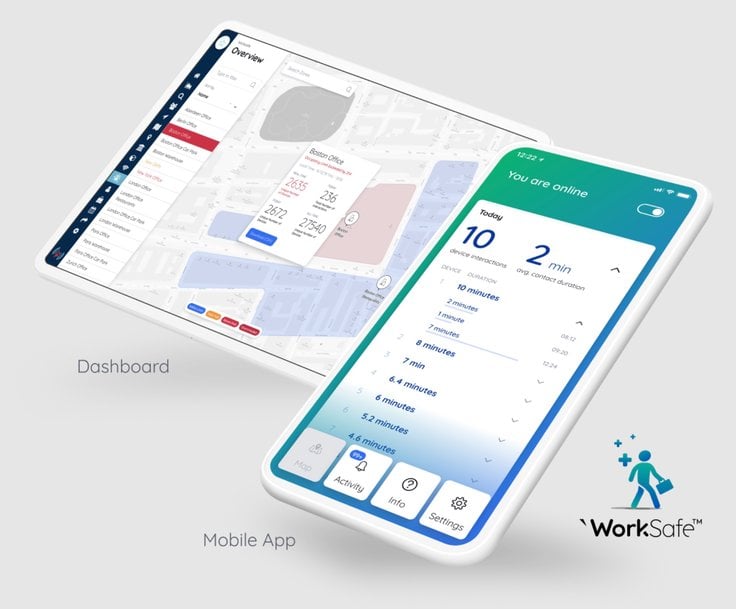
- What is 5G localization? And how does it work?
- How will 5G impact the indoor location industry?
- What are the current challenges of 5G geolocation?
Does 5G live up to its hype for indoor location? Is it ready to deploy in factories, retail stores, hospitals, workplaces, and other industries? In this article, we provide an overview of the current state of 5G localization. We compare 5G positioning to other indoor location technologies available today, such as Ultra-Wideband, Bluetooth, and Wi-Fi, to help organizations choose the best technology to deploy location services.
What is 5G localization and how does it work?
5G is the fifth generation of mobile connectivity. It is a new global wireless standard after 4G networks. It is advertised as superior to 4G in many ways. 5G operates through MIMO (Multi-user Multiple Input Multiple Output) antennas, which provide a precise orientation of the signal in one specific direction instead of a multidirectional broadcast. Before we can all use it, wireless companies have to upgrade their radio antennas to work with the new network, and phone makers have to upgrade chips in their phones.

Unlike 4G, 5G does operate through MIMO (Multi-user Multiple Input Multiple Output) antennas, which act as directional headlights, for precise orientation of the signal in one specific direction, instead of a multidirectional broadcast.
What frequency is 5G? As 5G can utilize a wide range of bands from lower bands like 3G and 4G up to very high-frequency bands, that’s a tricky question. The 5G network that is rolled out nationwide by major carriers today lives in the low-frequency bands, also referred to as Sub-6GHz bands. While Sub-6GHz 5G networks can handle more users than 4G networks, they don’t show substantial speed improvements compared to 4G.
So what is the “super-fast” 5G that is advertised as revolutionary? That would be high-band 5G, which lives between 24GHz and 100GHz (see Fig.2). This type of 5G can handle a large chunk of data allowing speeds to go over 1 Gbit/s. It is referred to as mmWave by Qualcomm and AT&T.
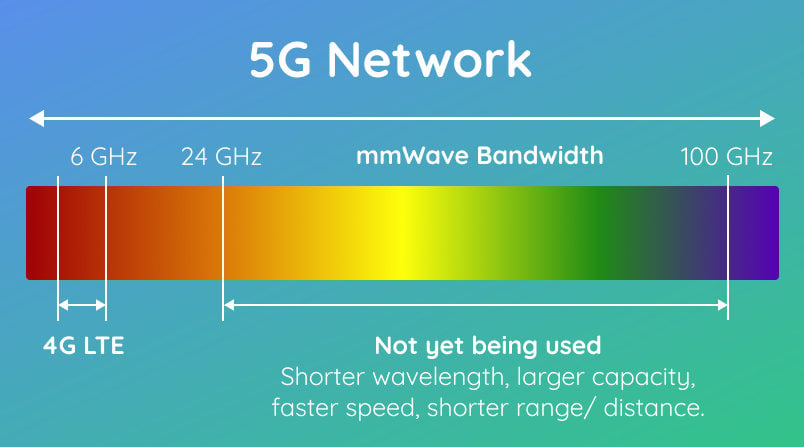
5G network explained: MmWave refers to the radio frequency spectrum between 24GHz and 100GHz that is not yet being used in nowadays 5G technology.
Can 5G achieve precise indoor localization?
Inside buildings and in dense urban areas, the super-fast 5G (mmWave) should be capable of achieving a positioning accuracy of 1 meter or below. This sounds promising, but mmWave is unfortunately not a reality just yet. For the time being, the 5G that most of us are going to experience is called sub-6GHz 5G, which is faster than 4G but not yet sufficient to be used for accurate indoor positioning systems.
How accurate are 5G networks for positioning?
mmWave vs. Sub-6GHz vs. 4G
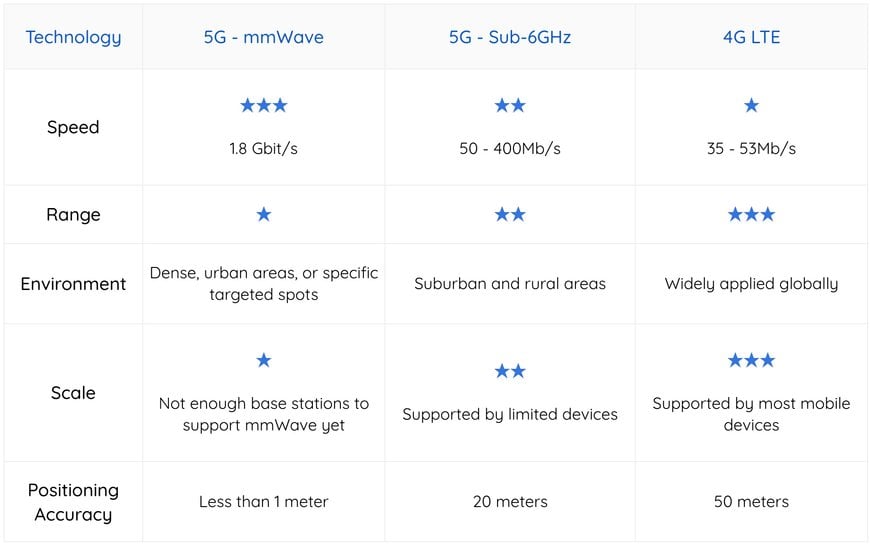
Comparison between 5G networks and 4G LTE
Why are major carriers slow to roll out mmWave, if it allows for high accuracy localization? That’s because it is expensive to deploy. It takes a long time and a lot of money to build a 5G cell tower. Sub-6GHz 5G can do more with fewer cell sites and make use of existing towers. This means that operators can improve the speed and consistency of mobile broadband more quickly with Sub-6GHz 5G than it is possible with a mmWave deployment.
As a result, though mmWave 5G could bring the next generation of localization technology, it is expensive to deploy and operators don’t see the economic value of rolling it out nationwide. For most people, the speeds available on 4G and Sub-6 5G are adequate enough. If you’re streaming a 4K video stream on Netflix for example, you only need 25Mbp/s.
mmWave has weak penetration and an ultra-short range
Another barrier to entry for mmWave is due to its technological limitations. mmWave 5G networks are ultra-fast, but they also have an ultra-short range and weak penetration. mmWave's performance can be affected significantly by doors, windows, walls, trees, vehicles and even humans. The density of base stations required to satisfy the quality of user experiences will be decided by the constraints of blockages and latency, rather than the requirements of coverage or capacity. Whereas 4G networks require 8-10 base stations per km², 5G networks would need as many as 40-50 base stations per km² (source: Newtec).
This diagram shows the difference of coverage between mmWave 5G base stations and lower-band base stations. The limitations of mmWave 5G make it best suited for dense, urban areas, or specific venues such as stadiums.
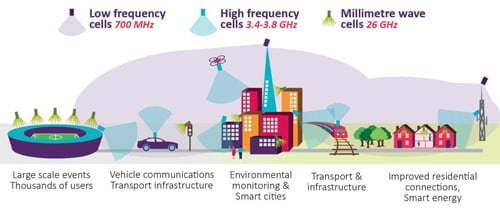
mmWave hardware provides very small coverage and will be focused on areas of high traffic demand, or to specific locations requiring services with very high capacity.
With mmWave, indoor coverage is a challenge
As mmWave doesn't penetrate through walls, even if carriers installed mmWave base stations at the top of each building, the 5G coverage wouldn’t propagate indoors.
mmWaves don’t penetrate inside buildings

Instead, building operators would need to build their own private 5G network indoors in partnership with operators and purchase expensive 5G hardware to enable applications such as highly accurate indoor positioning. As mmWave technology does not penetrate walls, the hardware (“smart cells”) would need to be mounted in every room.
When trialing their 5G hardware in indoor environments, Qualcomm has found that for a 27,000 sqft office with just one floor, they would need to deploy 20 mmWave small cells, which would have to be connected to a base station, to achieve over 90% coverage. For multi-story buildings, you would need to install hardware on every floor. Due to the high density of expensive 5G hardware required, deploying private 5G networks indoors would only make sense for a convention center or a stadium, where there aren't many walls.
The density of 5G hardware required in a single floor office
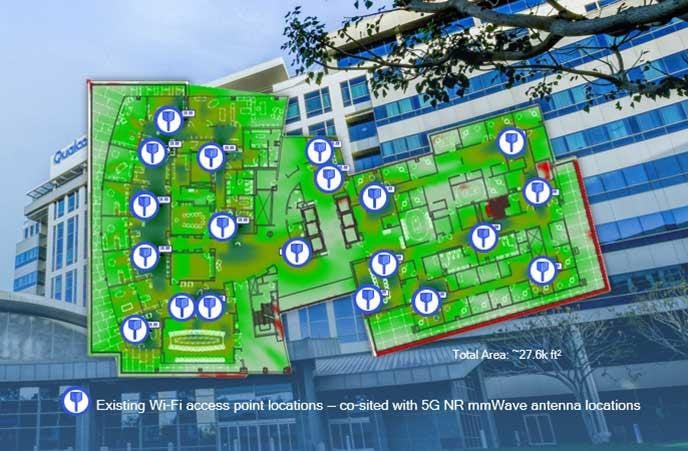
In summary, 5G is a promising technology, but it currently cannot be used at scale for indoor positioning inside buildings due to technological limitations and high deployment costs.
What are the other indoor positioning technologies available today and how do they compare to 5G?
In conclusion, we believe that 5G localization is a technology to watch for indoor positioning in the future. However, no one has implemented 5G localization yet, and people only talk about the possibilities of 5G for indoor location in theory. It is currently at a disadvantage of not being handled by most of today’s smartphones and mobile devices.
How can venue operators enable location services in their buildings today in a highly scalable, cost-efficient, and future-proof way? This overview compares the various indoor positioning technologies available today to help you make an informed choice.
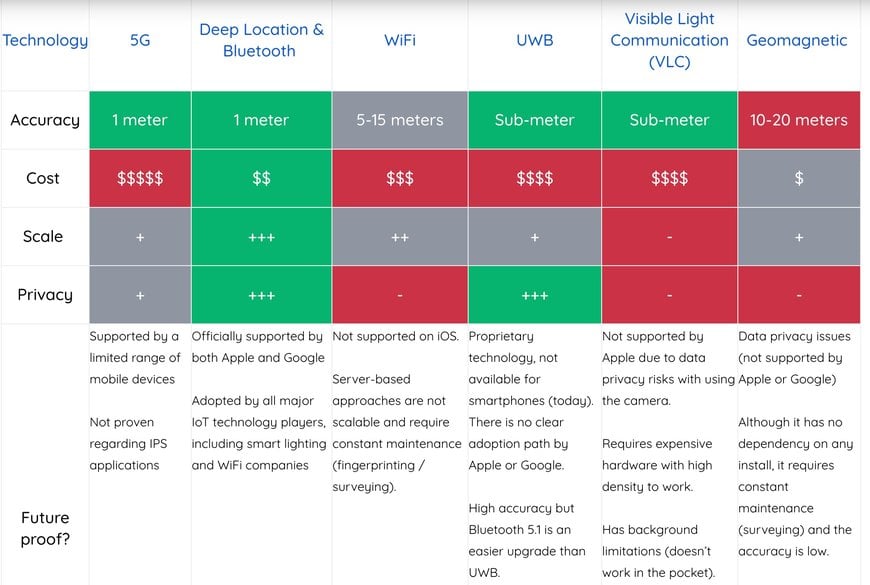

Comparison between 5G localization and other indoor location technologies that are available today.
5G and Deep Location®: the future of indoor location?
At Pointr, we invest heavily in R&D to ensure we stay well-positioned to bring our customers and partner the best indoor location technology. That’s why our R&D team is already testing 5G localization technology with our Deep Location® platform. Our Deep Location® algorithms are hardware and technology agnostic, and we will launch updated SDKs if and when we start seeing the adoption of 5G technology. We think that 5G localization will take some time to be affordable and widespread, but it has the potential to become the future of indoor positioning systems.
Pointr Deep Location® is a hardware-agnostic software platform resulting from years of R&D into high scale indoor location and mapping, protected by 18+ international patents. We partner with all major infrastructure providers, including Cisco, Honeywell, Panasonic, GE Current, and Extreme Networks, to provide the only complete and scalable location system.
www.pointr.tech.com

